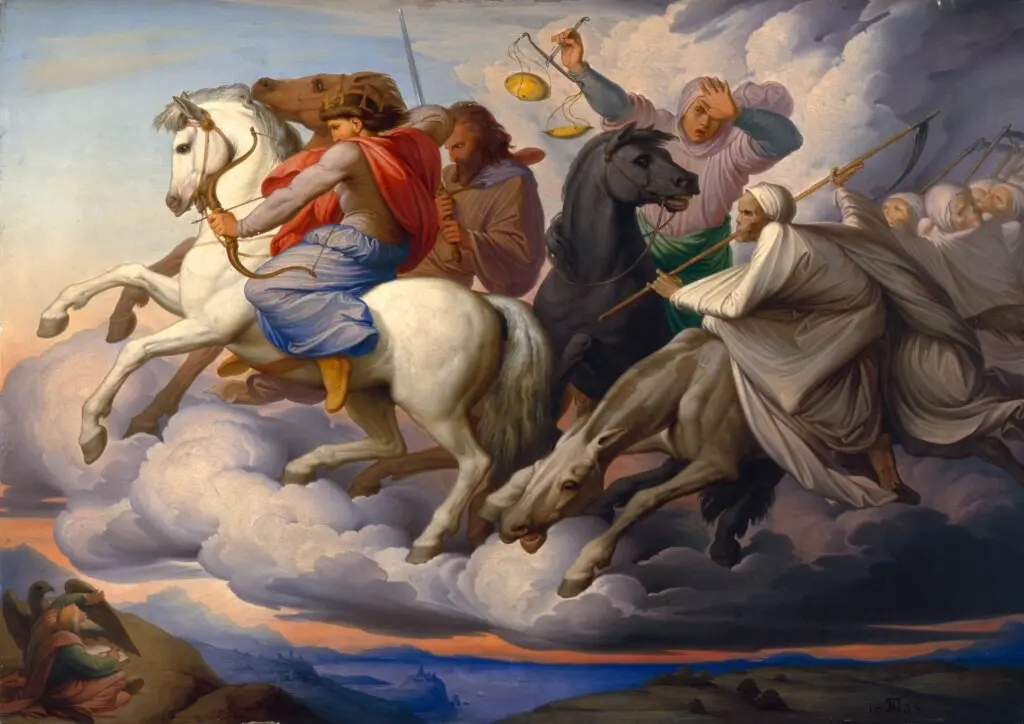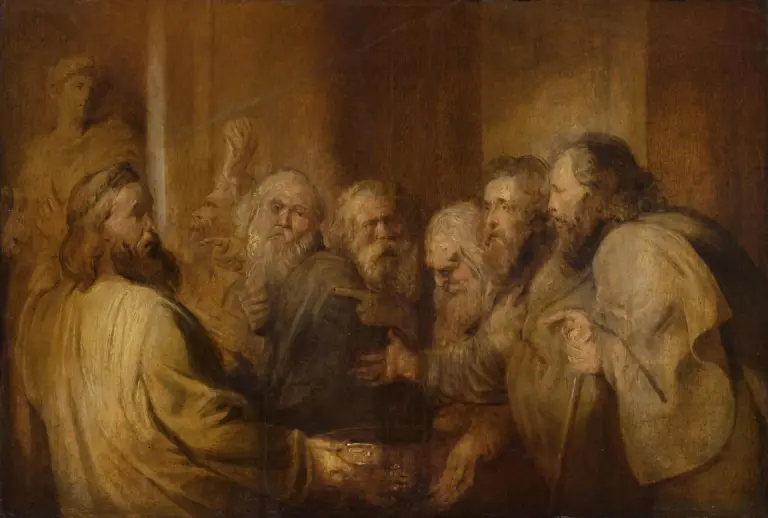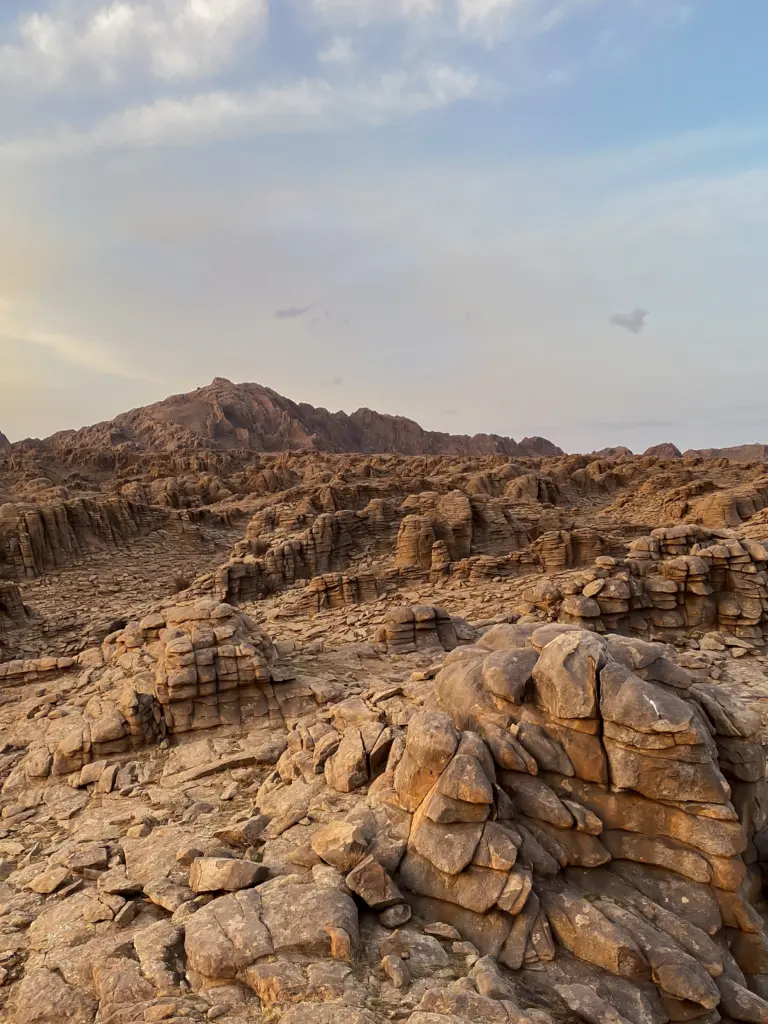As I got more into Hinduism, I ended up reading stories such as the Ramayana and the Mahabharata. It’s where I first encountered Vishnu, a prominent deity revered for his role as the preserver and protector of the universe. Though during those stories, I was actually reading about his avatars – Rama and Krishna respectively – who are amongst the most popular of his ten avatars.
Today, we’re going to take a closer look at Vishnu and his ten famous avatars, collectively known as Dashavatara. You’ll find that each avatar has its own unique narrative, rich with lessons, symbolism, and an occasional surprising fact or two!
Table of Contents
ToggleWho is Vishnu?
Vishnu, often known as the “Preserver” in Hinduism, is one of the most revered deities in the Hindu Trimurti (Trinity), which also includes Brahma, the “Creator,” and Shiva, the “Destroyer.”
Seen as the caretaker of the universe, Vishnu is deeply loved for his protective nature and his dedication to preserving balance.
The idea is that when the world and the principles of life – known as “Dharma” – are under threat, Vishnu leaves his heavenly abode in Vaikuntha to take an earthly incarnation to restore the equilibrium.

What are Avatars?
Avatars aren’t those blue aliens you might be thinking of, nor are they benders of the four elements, rather they are deities that descend to the earthly realm to restore Dharma whenever it’s under threat.
The term “Avatar” originates from the Sanskrit word “Avatara,” which literally means “Descent”. These avatars, while fully divine, take on earthly forms and experience human realities, making them relatable figures for many people.
Vishnu is famous for incarnating in various forms across different ages (Yugas). These incarnations aren’t limited to human forms; Vishnu has manifested as animals, sages, and even princely warriors, each form chosen to suit the needs of the era.
Avatars aren’t limited only to Vishnu and other deities have several avatars as well, such as Shiva and Lakshmi.
What does Dashavatara mean?
The term Dashavatara also originates from Sanskrit and is a combination of two words: “Dasha,” meaning ten, and “Avatara,” meaning descent.
So, Dashavatara essentially translates to “Ten Incarnations”. This refers to the ten primary avatars that the Hindu deity Vishnu is said to have taken on earth to restore dharma.
The Dashavatara outlines the cyclical nature of time and symbolizes evolution from the simplest life form to the most complex as you might notice as we progress through each below.
The 10 Incarnations of Vishnu
1. Matsya - The Fish
The tale of Matsya, the first avatar of Vishnu, begins with a small fish in a river. This fish was unlike any other – it was Vishnu himself in disguise. One day, the tiny fish swam into the hands of a kind-hearted king named Manu who was bathing in the river. The fish pleaded with the king for protection from the larger creatures of the river that could potentially harm it.
Manu, moved by the creature’s plea, decided to help. He placed the fish in a small bowl, but the fish kept growing. It grew so much that Manu had to move it to a larger vessel. However, even that wasn’t enough. The fish kept growing, and eventually, it had to be moved to the royal pond. Still, the fish continued to grow until it became as large as the pond itself.
Baffled by this phenomenon, Manu realized that this was no ordinary fish. It was then that the fish revealed its true form as Lord Vishnu.
Matsya, or the fish avatar, had come to warn the king of an impending deluge that would destroy the world. He instructed Manu to build a large ship and gather samples of every living creature and plant species to ensure their survival.
As the world drowned in the catastrophic flood, Matsya guided Manu’s ship through the perilous waters, saving all the lifeforms aboard from annihilation.
Does the story sound familiar? It’s like the Hindu version of “The Great Flood“!
Another fun fact: Matsya can be seen as symbolizing the first stage of evolution according to Darwin’s theory. The avatar started as a marine creature, aligning with the belief that life originated in water. It’s not every day that ancient myths and modern science find a common ground, is it?
2. Kurma - The Tortoise
Long, long ago, the Devas (gods) and Asuras (demons) were in constant conflict with each other. One day, they realized that the only way to attain immortality was by consuming Amrita, the nectar of immortality, which was at the bottom of the cosmic ocean.
Deciding to work together to churn the ocean and retrieve the nectar, they used the mighty Mount Mandara as the churning rod and the great serpent Vasuki as the churning rope. But, as they began churning, they encountered a massive problem. The mountain began to sink into the ocean due to its immense weight.
At this crucial moment, Lord Vishnu took the form of a colossal tortoise, known as Kurma, and dived into the ocean. He positioned himself under the mountain, providing a firm support for it on his vast, sturdy shell. The Devas and Asuras resumed churning, and eventually, the much-coveted Amrita emerged, leading to further tales.
This episode is known as the “Churning of the Ocean of Milk,” you can find depictions of this scene in many places around the world such as Bangkok’s airport or in the bas-relief’s of Angkor Wat.
You may have also noticed, just like Matsya, the hands of Kurma are in the position of the Abhaya Mudra, a hand gesture symbolizing protection which is one of Vishnu’s most prominent qualities as the protector of the universe.
3. Varaha - The Boar
As the story goes, the demon Hiranyaksha had grown in power, practicing harsh austerities and gaining boons from Brahma. With his newfound power, he brought about destruction and chaos, eventually dragging the Earth to the bottom of the cosmic ocean.
Vishnu, seeing the affliction of the Earth and its beings, decided to intervene. He took the form of a great boar – Varaha. In some depictions, Varaha emerged from the nostril of Brahma as a tiny pig, but he grew to an enormous size.
With a terrifying roar, Varaha dove into the depths of the ocean in search of the Earth. A fierce battle ensued between Varaha and Hiranyaksha, lasting a thousand years. In the end, Varaha slew the demon with his tusks.
Then, in a gentle act after such a brutal battle, Varaha lifted the Earth on his tusks, carefully bringing it back to its rightful place in the cosmos.
The story of Varaha shows Vishnu’s willingness to dive into the depths of chaos (literally) to restore harmony, showing his love to all that is.
4. Narasimha - The Man-Lion
Vishnu’s fourth avatar, Narasimha, took a truly unique form: half-man and half-lion.
Hiranyakashipu, the brother of the demon slain by Vishnu’s Varaha avatar, was enraged by his brother’s death and swore vengeance against Vishnu and his followers. He undertook severe penances and was eventually granted a boon by Brahma (one might wonder, why does he keep giving these guys boons?) Believing this boon would grant him invincibility, he demanded that he not be killed during the day or night, inside or outside, by man or beast, on earth or in the sky, nor by any weapon.
His son Prahlada, however, remained a devoted follower of Vishnu. This infuriated Hiranyakashipu, who subjected Prahlada to cruel punishments, none of which affected the boy due to his unwavering devotion.
Witnessing his devotee’s distress, Vishnu appeared from a pillar in the form of Narasimha at twilight (neither day nor night), on the threshold of the courtyard (neither inside nor outside), placed Hiranyakashipu on his lap (neither earth nor sky), and eviscerated him with his lion claws (no weapon). Brutal.
Narasimha’s tale teaches the victory of faith over persecution. It also communicates the message that divine protection is always bestowed upon the truly devoted, no matter the odds. Moreover, it shows that evil, despite its seeming invulnerability, can never triumph over divine forces.
5. Vamana - The Dwarf
Vamana is often depicted as a dwarf but don’t let that fool you.
During the time of Vamana, the demon king Bali had taken over the universe through sheer power.
He was the grandson of Prahlada, the devotee of Vishnu during the time of Narasimha, and had a reputation for being a generous and righteous king. However, his dominance over the cosmos was not part of the divine order.
To restore balance, Vishnu took the form of a dwarf named Vamana and approached Bali, who was conducting a grand sacrifice and giving away gifts generously as part of his display of power. Vamana asked Bali for just as much land as he could cover in three steps.
Bali, bemused by the small request, agreed. Suddenly, Vamana grew to an enormous size, covering the earth and the heavens with two steps. For the third step, Bali, realizing Vamana’s divine nature and keeping his promise, offered his own head as the last step. Vamana placed his foot on Bali’s head, pushing him to the underworld.
However, due to Bali’s devotion and humility, Vishnu granted him the boon of becoming the king of the underworld and also promised him that he would be a future Indra, the king of the gods.
Vamana’s story illustrates that unchecked power and arrogance can be tamed by humility and that God rewards those who are true to their word, even in the face of great adversity. It also shows that no act of generosity goes unnoticed by the divine.
6. Parashurama - The Axe-Wielding Brahmin
Parashurama is the first avatar to be born as a human, and is the only avatar considered to be both alive and immortal, residing on earth for all of time. His name “Parashurama” means “Rama with an axe”, which is his weapon of choice.
Parashurama’s story is set during a time when the ruling Kshatriya class had become tyrannical, abusing their power and neglecting their duties to protect and maintain Dharma.
In their arrogance, they had begun to oppress the Brahmins, the priestly class dedicated to spirituality.
Born into a Brahmin family, Parashurama was the son of the sage Jamadagni and his wife Renuka. One day, a group of Kshatriyas led by King Kartavirya killed Jamadagni over a dispute concerning a divine cow. Enraged by this injustice, Parashurama vowed to eradicate the earth of these corrupt Kshatriyas.
Armed with an axe given to him by Lord Shiva, Parashurama went on to wage war against the Kshatriyas, and it is said that he cleared the earth of them twenty-one times. This wasn’t an act of genocide, but rather symbolic of wiping out the tyranny, the oppression, the adharma that the Kshatriyas had come to represent.
Despite his warrior-like actions, Parashurama is also known for his spiritual accomplishments. He is said to be a master of ancient martial arts, including the art of warfare known as Dhanurveda. He’s also regarded as the guru who passed on these arts to warriors like Bhisma, Drona, and Karna who appear in the epic Mahabharata.
Parashurama’s tale underscores the concept that no one is above Dharma, not even the ruling class. It underlines the divine promise that whenever adharma threatens to tip the balance, God will intervene, even if it means going to war against the very class ordained to protect the world.
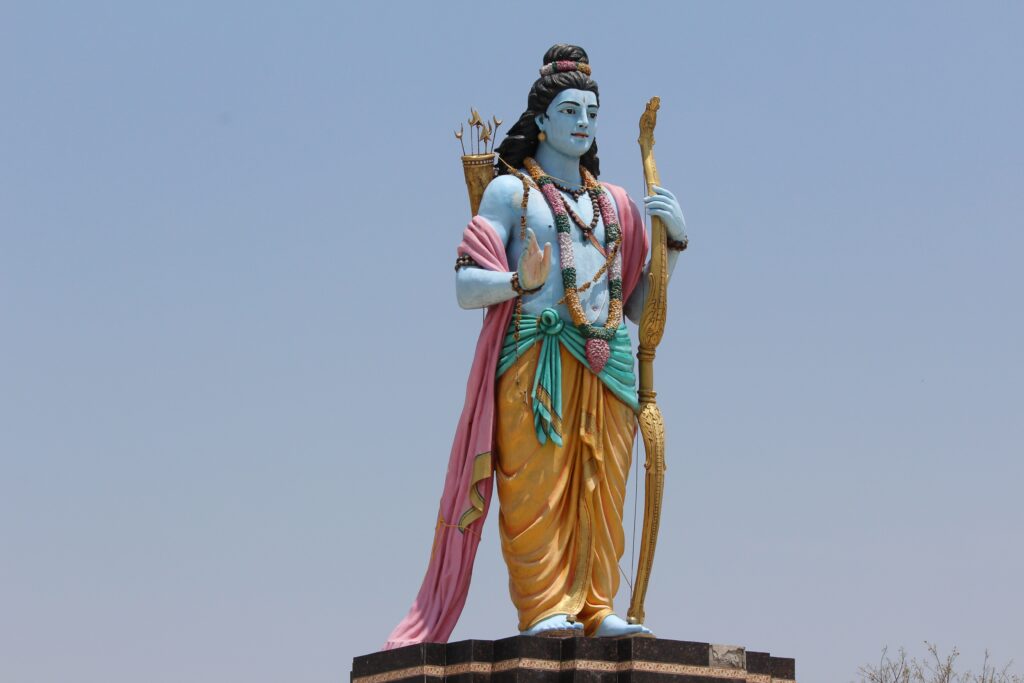
7. Rama - The Hero
Rama is one of the most celebrated figures in Hinduism, being the protagonist of the epic Ramayana which you can read more about here.
Rama’s story is much more than just an epic though – it’s a guide to leading a virtuous life, embodying the ideals of Dharma.
Born as the prince of Ayodhya, Rama was known for his humility, wisdom, and unwavering commitment to Dharma. He is widely revered for his courage, prowess in battle, and deep devotion to truth and justice. His reign, known as Ram Rajya, is synonymous with a time of peace, prosperity, and righteousness.
The epic Ramayana revolves around Rama’s life, his wife Sita (who is an incarnation of Lakshmi, Vishnu’s consort), his brother Lakshman, and his loyal devotee Hanuman. The story unfolds with Rama’s exile from his kingdom, his wife Sita’s abduction by the demon king Ravana, and the subsequent war in Lanka where Rama, along with an army of monkeys led by Hanuman, defeats Ravana and rescues Sita.
Rama embodies the virtues of a model son, a loving husband, a caring brother, a compassionate king, and a loyal friend. His life and teachings have had a profound influence not only on Indian culture but even other civilizations from Malaysia, Thailand and even Indonesia.
The story of Rama also emphasizes the concept of Dharma in complex situations. Despite being wronged and tested throughout his life, Rama remains steadfast in his commitment to Dharma, setting an example that righteousness can indeed overcome evil, no matter the circumstances.
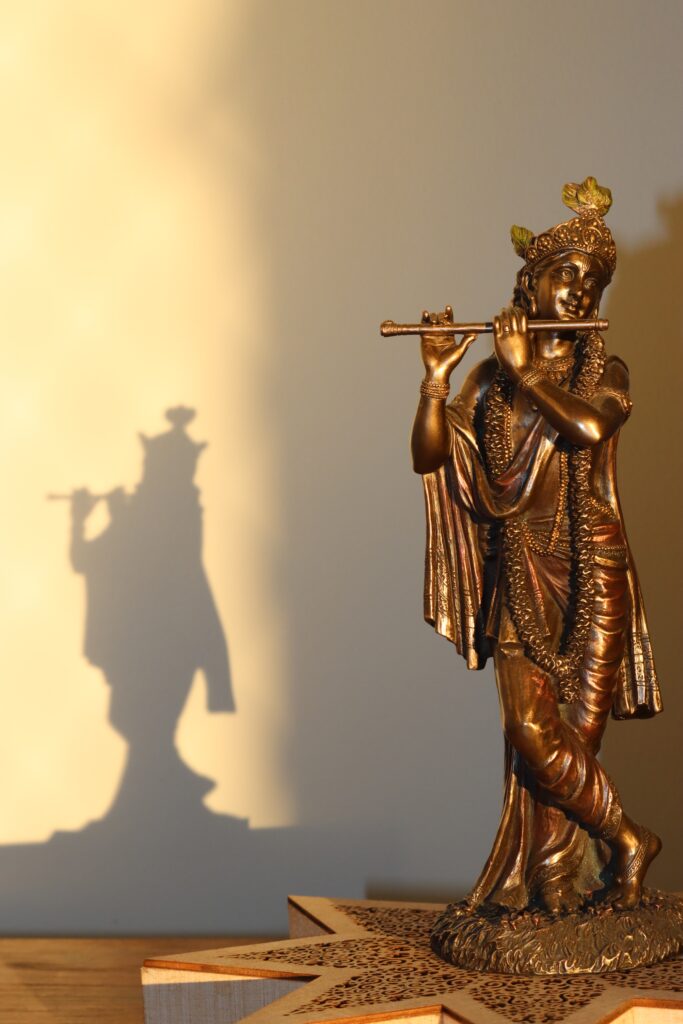
8. Krishna - The Cowherd
Krishna is perhaps one of the most beloved and revered figures in Hinduism. He plays a key role in the epic Mahabharata and is the speaker of the Bhagavad Gita, one of the most important spiritual classics in the world. The Hare Krishna mantra is based on both Krishna and Rama’s name. Krishna’s association as a cowherd is why cows are considered sacred in India!
Krishna’s story begins in the city of Mathura, where he was born to Devaki and Vasudeva in a prison cell, as his evil uncle, King Kamsa, had been foretold that Devaki’s eighth son would cause his demise. Miraculously saved and smuggled out of the prison, Krishna was raised by foster parents, Yashoda and Nanda, in the idyllic village of Vrindavan.
His childhood and adolescence are filled with tales of divine playfulness, miracles, and enchanting interactions with the gopis (cowherd girls), including his eternal consort, Radha. These episodes, known as Leelas, symbolize divine joy.
In his later life, Krishna becomes a key character in the epic Mahabharata, where he plays the role of Arjuna’s charioteer. On the brink of a great war, when Arjuna is filled with moral dilemma, it is Krishna who imparts spiritual wisdom through a conversation that comes to be known as the Bhagavad Gita (Song of God). This discourse covers various paths to spiritual realization, the nature of the universe, and the principles of duty, righteousness, and selfless action.
Krishna’s life and teachings have had a significant influence on Hindu philosophy and culture. He is revered as a supreme god in his own right, the embodiment of love and divine joy, and an inspiration for devotion and righteous living. He is also remembered for his messages on the duty towards one’s moral responsibilities (dharma), the paths to spiritual enlightenment, and the impermanence of life.
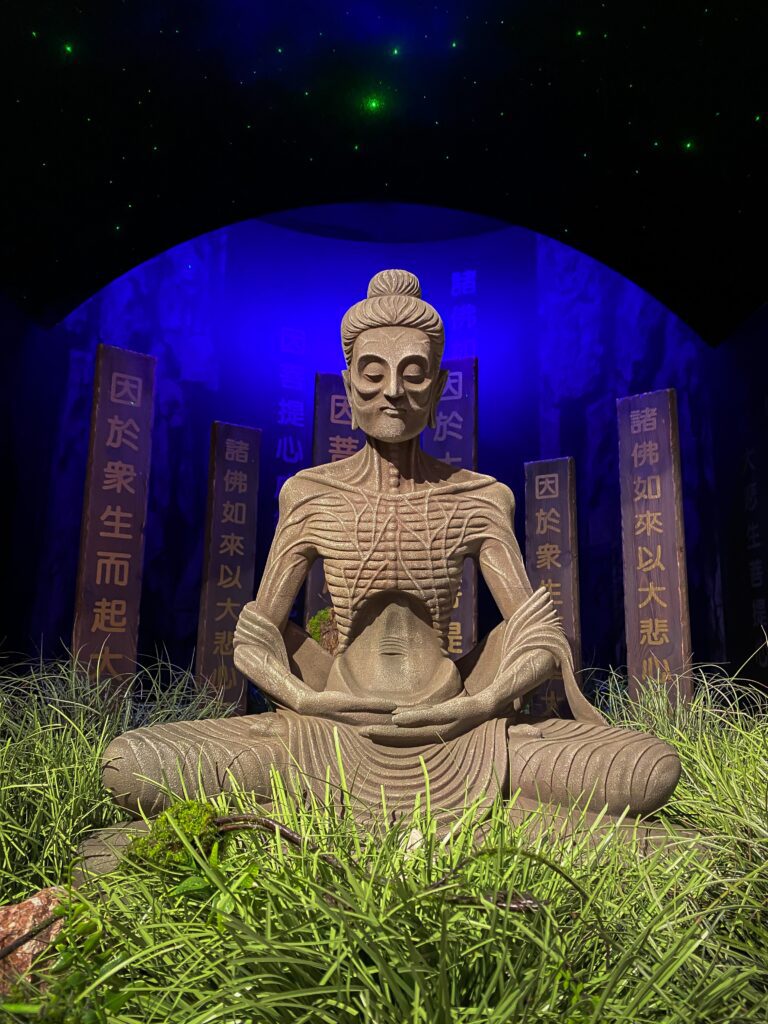
9. Buddha - The Enlightened One
The ninth avatar of Vishnu, according to certain traditions, is Buddha, also known as Gautama Buddha, the founder of Buddhism. This inclusion, though, is viewed with some contention as Buddhism is a distinct from Hinduism. Balarama is also considered as the 9th avatar but the Buddha sounds a lot more interesting for me so I’ll go with him.
The story of Buddha begins with his birth as Prince Siddhartha Gautama, in the 5th century BCE, in Lumbini (in present-day Nepal). Siddhartha was a royal prince, living a life of luxury and abundance, sheltered from the harsh realities of the outside world. However, upon venturing outside his palace, he was confronted with the inevitable sufferings of life – old age, disease, and death. These experiences deeply disturbed him, leading to a profound existential crisis.
To seek answers to his burning questions about life, suffering, and death, Siddhartha renounced his royal life and embarked on a spiritual quest as a wandering ascetic. After years of rigorous meditation and self-discipline, he attained “Enlightenment” under a Bodhi tree in Bodh Gaya, thereby earning the title “Buddha,” which means “The Enlightened One.”
Buddha’s teachings, encapsulated in the Four Noble Truths and the Eightfold Path, offer a practical guideline to end suffering and attain a state of transcendent happiness known as “Nirvana.” His philosophy stressed the middle path, avoiding both severe asceticism and indulgent sensuality. You can read more about the Buddha’s teachings in my article on Theravada Buddhism.
While the acceptance of Buddha as an avatar of Vishnu was likely an attempt at integrating Buddhism into the fold of Hinduism, the teachings of Buddha, particularly the concept of “Anatman” (no permanent soul), stand in contrast to the key Hindu concept of “Atman” (eternal soul). So there is room for some contention indeed.
9.5 Balarama - The Plough Bearer
That being said, let’s go over Balarama as well. Balarama is often considered the elder brother of Krishna. He is renowned for his might and carrying his weapon of choice, the plough, signifying his deep connection to the earth and agriculture.
Balarama also played a significant role in many tales of Krishna, providing support, wisdom, and sometimes even comic relief. While not as central to the narrative as Krishna, his presence is a constant, reflecting the strength of fraternal bonds and the value of loyalty and companionship.
One of the most riveting aspects of Balarama’s life is his neutrality during the Kurukshetra war (in the Mahabharata). Despite his close relationships with both parties, he chose not to participate in the war, symbolizing his fairness and respect for the principle of dharma.
10. Kalki - The Future
Unlike the other avatars, Kalki is yet to arrive. That’s right, Kalki is a figure of the future, predicted to appear at the end of Kali Yuga, our current age of darkness and turmoil. Similarly, Buddhism also has the “Future Buddha” known as Maitreya.
According to Hindu scriptures, when the world is overwhelmed with evil and righteousness is lost, when greed, corruption, and power rule the world, then Kalki will appear. It’s said that he will ride a white horse named Devadatta and wield a flaming sword, charging through the darkness to restore Dharma, righteousness, and purity.
Kalki is seen as the ultimate destroyer of evil, but also as the herald of a new age. After his mission is complete, it is said that the world will restart, and the cycle of Yugas will begin again with Satya Yuga, the age of truth and righteousness.
Even though Kalki signifies the end of an age, it’s not an apocalypse scenario. Instead, it’s seen as a time of renewal.

